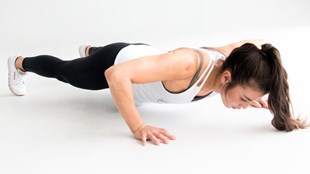Jinger Gottschall, Associate Professor at Penn State University and lead researcher of the study, says knee push-ups are in fact beneficial for building and maintaining strength, and she now has the scientific evidence to back it up.
“Knee push-ups have been considered the easy version without the same benefit as toe push-ups, but now we have the data to demonstrate the benefits for safe training,” Gottschall says.
The results show that while the overall muscle activation was greater during the toe push-ups – due to the extra load on the upper body – the contribution from each of the muscles was similar for the two variations. This means that you are training the target muscles in the same way, just using less load when you are on your knees.
This is good news for people who cannot safely or successfully perform push-ups on their toes with a full range of motion.
“Our advice to many people for whom this is the case – don’t leave push-ups out of your workout because you cannot perform them on your toes. Knee push-ups are a valuable alternative to toe push-ups in order to give your chest, shoulders and arms a quality workout, at the same time strengthening the muscles of the core,” Gottschall says.
In the study, 12 healthy male participants who completed strength training twice per week were measured using electromyography (EMG) signals while performing push-ups on both the knees and the toes.
EMG records the electrical activity of muscle using surface electrodes attached to the skin. The study participants completed a five-minute warm-up on a stationary bike and then completed a series of push-ups on the knees and toes as well as bench presses.
Researchers also concluded that if a person performs enough knee push-ups to reach a point of fatigue, they will eventually become strong enough to do push-ups on the toes – again because the muscle activation pattern in both types of push-ups is similar.
Gottschall recommends that once a person is confident doing 16 push-ups on the knees, he or she is then ready to try push-ups on the toes.
“If you can comfortably do 16 knee push-ups, our message is to start trying to do a couple on your toes and see how you feel. If you need to, revert back to the other style until you gradually build up your strength over time to be able to do more on your toes than your knees,” she says.
The study also found push-ups to be more effective as a functional exercise than the bench press, with participants experiencing 51 percent more activation of the abdominal muscles when completing push-ups versus bench press repetitions. Functional exercises train muscles to do everyday activities safely and efficiently and often involve the integration of limb muscles with those in the core.
Les Mills International supported this research study at FITOLOGY, a group fitness and cycling studio located at State College, Pennsylvania.






